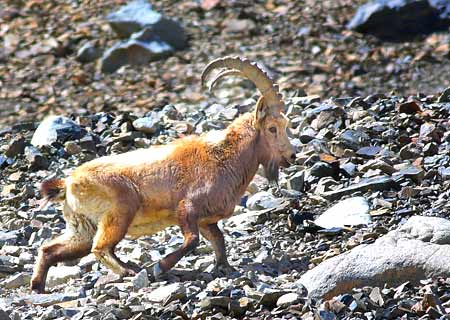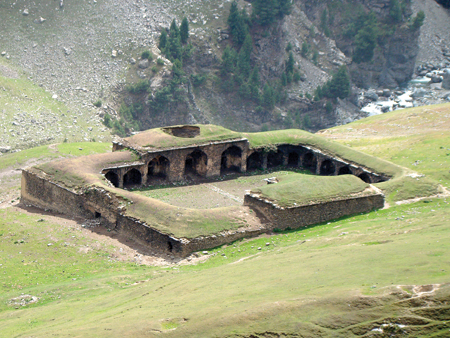Two decades of armed militancy has given Kashmir’s wildlife an unexpected lease of life by keeping poachers away. Now the artillery falling silent along LoC is helping Markhor return from the brink of extinction. Kainaat Mushtaq reports.

Nearly seven years after Indian and Pakistani artillery guns on the Line of Control (LoC) fell silent in November 2003, an unusual peace dividend has appeared in the scenic region. The rare majestic goat called the markhor has made a comeback.
Markhor either fell victim to or was scared away by regular artillery and machine-gun fire across its high-altitude habitat on LoC, the disputed line that runs through the goat’s habitat. Markhor, which is also Pakistan’s national animal, had not been seen for years.
“It is absolutely fantastic that they are back,” said Abdul Rauf Zargar, wildlife warden responsible for the high-altitude markhor sanctuary, Qazinag near Uri.
State’s Wildlife Department has already converted Lachipora and Limber sanctuaries with Nagnari conservation reserve into over 211 sq km Qazinag National Park, a vast protectorate for the animal. Geology and Mining Directorate has cancelled all the leases for gypsum mining in the protected areas. Interestingly, Lachipora Wildlife Sanctuary has more soldiers than animals and its one end is de facto border (LoC).
Three contiguous reserves were converted into a park as a follow up to a 2005 survey, the first exercise in last 20 years to enumerate the Markhor. Barring Gulmarg range, the survey sighted 35 herds comprising 155 goats in Hirpura (located between Poonch and Shopian) and Qazinag reserves. J&K, right now, has three national parks – Dachigam (Kashmir), Kishtwar (Jammu) and the high-altitude Hemis (Ladakh), with focus on Hangul, musk deer and snow leopard respectively – besides 14 wildlife sanctuaries and 34 conservation reserves.
An elusive mammal, markhor (Capra falconeri) is the world’s largest species of goat and is recognised by its trademark spiralling corkscrew horns that can grow more than a metre long – which also makes the animal prized for traditional Asian medicine. For a long time it has fascinated Western hunters. A German army major Count Hans Von Koenigsmarck in 1910 wrote a detailed account of markhor based on his experiences in Hirpora sanctuary. The book ‘Markhor Sport In Cashmere’ was translated into many languages.
Wildlife authorities in Kashmir said the goat had not been sighted since the mid-1990s because of rising tension on the Kashmir frontier between rival armies. Continuous shelling between rival armies, massive deployments and heavy movement of men and material created classic instances of biotic interventions forcing the goat into near extinction. In 1997, TJ Roberts reported the goat with shaggy winter coat “has been practically exterminated by troops stationed in the border region” but George Schaller “estimated the existence of around 250-300” in J&K’s semi-arid cliff-side mountains called the Pir Panchals.
“The recent and the first authentic census in Qazinag Park shows the presence of at least 300 animals. This is a very significant number,” Rauf Zargar added. A 2005 survey by wildlife experts had sighted only 155 markhors in the area. “One of the main reasons behind the markhor’s comeback is peace on the border,” Zargar said.
Hundreds of people have been killed and thousands wounded on both sides of the frontier till the rival armies exchanged daily artillery duels and small arms fire across the rugged border.
Although the new sightings were good news, conservationists said they were worried that the markhor’s habitat had been divided by an electrified fence by India to stop incursions of militants into Kashmir. “I am sure on the other side of the LoC (PaK), the population has also increased. Now the only worry about the markhor’s future is the electrified fence along the LoC,” a senior wildlife official said.
The serpentine fence not only divides the habitat but also limits wild life’s cruising range. This physical obstacle has forced the main predator – the leopard cat – to move inwards as a result of which man-predator conflict is on rise and the toll is substantial.
Taking advantage of a ceasefire agreed in 2003, the army has built a three-metre (yard) high barbed wire security fence along most of the 742-km (460-mile) LoC. But militants seem to have breached the barrier despite the area being heavily mined.
The sightings have raised hopes that the markhor is no longer as close to extinction in Kashmir as earlier thought. “Shelling was a serious threat. Peace on the borders has really helped the markhors. We are delighted,” Ghulam Hassan a villager, living close to LoC said. Experts said there were an estimated 400-550 markhors in Kashmir in 1977 despite the animal being poached by hunters.
The goat, which has a shaggy winter coat ranging from light brown to black, lives in semi-arid cliffside mountain areas of India, Pakistan, Afghanistan, Tajikistan, Uzbekistan and Turkmenistan.
It has been hunted for its horns, hoofs and meat, depleting its numbers. Apart from the medicinal value that various cultures attach to the goat’s horns, its meat is considered to be the rich source of ‘bush protein’. In the 1970s, it was estimated there were between 20,000-25,000 markhors worldwide. By 1997, the Worldwide Fund for Nature put their number at just a few thousand.
The animal was embroiled in another controversy in the hinterland where the state government was keen to lay an alternative Kashmir highway connecting the valley with the twin border districts of Poonch and Rajouri.

Laying a road on the dirt track that Mughal emperors used to annex Kashmir with India had remained a dream throughout. Work on it started during halcyon days but was abandoned after the militancy erupted in 1990. Resuming work on the highway was resisted initially by various policymakers and political parties thinking it will divert part of Jammu trade to Srinagar. They, however, projected it as a security risk, an issue that failed to make a mark given the keen interest that people in Kashmir on one side and Poonch-Rajouri on other side evinced in the project.
Finally, a lesser-known NGO Bio-diversity Conservation Trust petitioned before the apex court alleging that construction work would affect the region’s biodiversity including the movement of wild animals in the Hirpora Wildlife Sanctuary which is the potential source population for the conservation of markhors. It said the project will bisect the 149 sq km sanctuary into the north-western alpine area and the southeastern area, which is spread over alpine as well as forest ecosystems.
But supporters of the road, which is lined with historic Mughal era monuments, say it will be a tourist attraction and will also help ease the movement of Indian troops in the area. It triggered a long legal battle that state government finally won. The court stayed the progress on over 89-kms road in 2006.
After months of wrangling between environmentalists and the government, Supreme Court in July 2007 finally ruled that an ancient 16th-century road which runs through the sanctuary can be restored provided the adequate measures are taken for goat’s conservation.
The government agreed to donate five per cent of the total project cost to the conservation efforts, add additional 196.5 sq km to the existing sanctuary, skip macadamizing on various stretches of the road passing through the sanctuary.
Wildlife officials say they have already received over Rs 17 crores to their ‘species conservation plan’ and are planning to relocate about 200 Markhors to a nearby sanctuary after Supreme Court ended a year-long dispute and ruled that the Rs 268 crores Mughal road running through their habitat could be restored. The 86.9 km road is expected to be ready for commercial traffic early 2011.
The state wildlife authorities are also setting up it’s first Markhor captive breeding cum rescue centre deep inside the forests at Vadikhai village that falls in the Lachipora sanctuary and this will also be the county’s first Markhor breeding cum rescue centre.
The centre will be equipped with modern gadgets, with in-situ and ex-situ breeding facilities. Rescue enclosures and the veterinary hospital will also become the permanent home for weak and injured Markhors.
Overall wildlife population of Kashmir has registered a “manifold” increase as a two-decade-old insurgency has scared away poachers and hunters from the region, wildlife official say.
Rare birds like the black partridge and pheasant have increased in thousands while more Asiatic black bear, leopards, musk deer and hangul, now roam the scenic region’s pine forests.
But the increase in the number of predators including, black bear and leopards is another threat to markhor even though hunting in these belts is impossible in the wake of massive army deployments.















